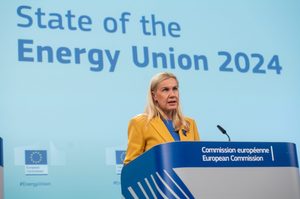European Commission report details $45 billion for clean energy, $800 million for hydrogen by 2030
September 27, 2024
The Commission released its State of the Energy Union Report 2024 on September 11, highlighting progress in the EU’s clean energy transition while emphasizing the persistent challenges to global competitiveness.
The annual report assesses the bloc’s progress toward its energy and climate objectives, and this year revealed a mixed picture of achievements and hurdles.
Central to the EU’s strategy is the Innovation Fund, an initiative financed through the EU Emissions Trading System (ETS), which is used to drive decarbonization and to penalize polluters. The fund has an estimated budget of €40 billion until 2030, intended to accelerate the deployment of clean technology in manufacturing across the region.
The European Hydrogen Bank, also financed by the ETS, has already made its mark by awarding nearly €720 million to seven renewable hydrogen projects in its inaugural auction in February 2024.
Global wind-power dominance; solar, batteries face deficits
The report detailed strides in the adoption of renewable energy projects.
Emissions are falling and renewables play a prominent role in our energy system today.
Maroš Šefčovič, executive VP of the European Commission for the European Green Deal
Renewable sources accounted for 50% of the EU’s electricity generation in the first half of 2024, according to the report. Wind power overtook gas to become the EU’s second-largest source of electricity behind nuclear power, signalling the change in the EU energy landscape.
The wind-power sector also stood out in trade performance. In 2023, wind technology showed a €1.7 billion trade surplus, with EU exports commanding a dominant 67% share of the global market. This positions the EU as a leader in wind energy technology internationally.
But the transition is not without its challenges. The report reveals a €19 billion trade deficit in lithium-ion batteries, despite this sector showing the highest production value in the EU in 2023 at €21 billion, a 30% increase from 2022.
This deficit increased by 21% compared with the previous year, highlighting the continuing struggle to achieve competitiveness in critical clean technology sectors.
Similarly, the solar PV industry in the EU, while growing, grapples with trade imbalances. EU solar PV production reached a value of €2.1 billion in 2023, but still showed a trade deficit, albeit one that decreased by 13% compared with the previous year.
The report also highlighted growth in other net-zero technologies. Heat-pump production value matched that of batteries with a 30% increase, while fuel cells output grew by 18%.
Ocean energy technologies, biofuels (ethanol), and carbon capture, utilization and storage (CCUS) all showed increases of nearly 10%.
Despite these gains, the EU faces growing competition in net-zero technologies in both global and domestic markets.
New legislation, national energy plans
The report also noted the urgent need to address high energy prices to boost EU industrial competitiveness.
“We should swiftly implement the new policy and regulatory framework to address the elevated energy prices and accelerate development of infrastructure.”

Kadri Simson, EU Commissioner for Energy
The report highlighted the role of the Social Climate Fund, set to mobilize at least €86.7 billion in the period 2026-32, to support vulnerable households and small businesses in the transition to clean energy.
The EU’s focus will shift to the implementation of recently adopted legislation and the analysis of the final updated National Energy and Climate Plans submitted by Member States.
These plans support the collective achievement of the 2030 energy and climate goals, with the Commission urging all Member States to submit their plans without delay to enable a swift and comprehensive assessment at the EU level.
These plans were due by June 30 this year and will determine the bloc’s trajectory toward its 2030 targets. It is now a question of how effectively they will be implemented and their effect on the EU’s energy transition.
Search
RECENT PRESS RELEASES
Related Post




